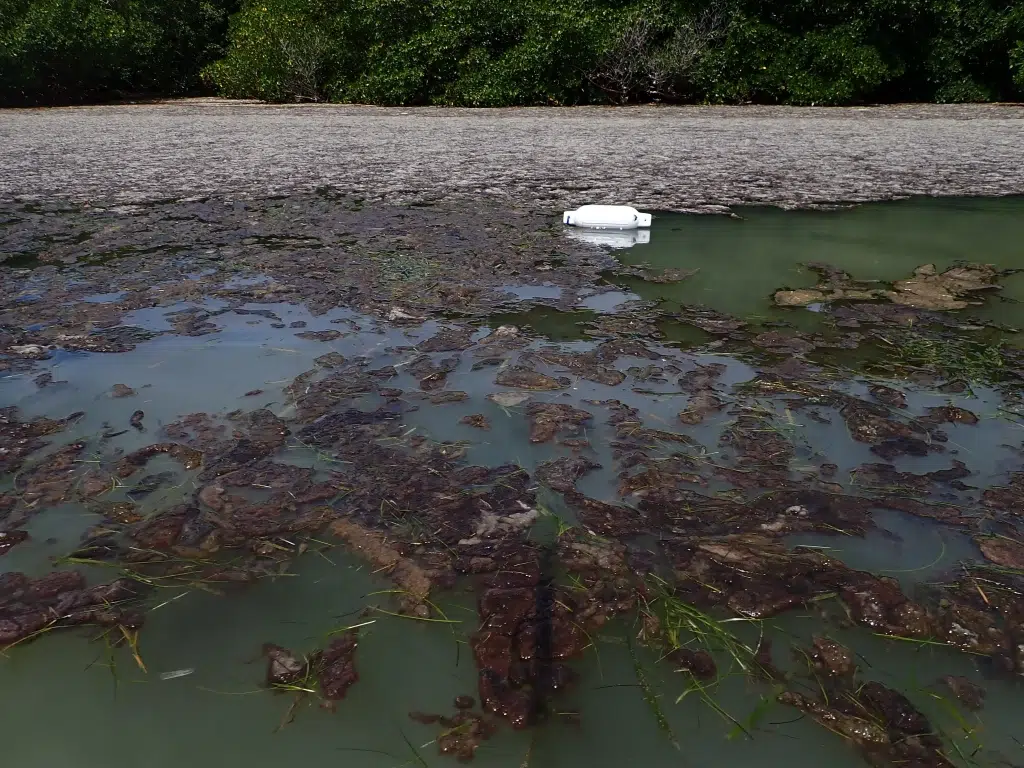Director’s Note: What a difference a year makes
As we enter the July 4th weekend, I think it’s worth noting how much better off we are – both Tampa and Sarasota Bays – compared to last year. For those who might not remember – Tampa Bay in the summer of 2021 was suffering through the worst red tide (in Middle Tampa Bay) since the 1970s. For Sarasota Bay, our shorelines in Anna Maria Sound were littered with huge rafts of decomposing cyanobacteria mats, which peaked in June of 2021.
In Tampa Bay, about 1,800 TONS of dead fish were hauled out of the bay in 2021– likely amounting to around 100 million fish. Last year, I was interviewed by TV stations and newspapers multiple times by reporters wondering what in the world was going on, and whether our two bays would be able to recover. My neighbors – who know what I do for a living – were constantly stopping me and asking me when the stench from the bay would start to die down – when could they start to enjoy going out to Emerson Point again. When could they go out on their porches and not gag on the odor of dead fish and decomposing algae.

We are not yet out of the woods – we still have issues that need to be addressed, and we still have incidents that are adversely impacting the bay’s health. We still have boats leaving prop scars in our grass beds, people not picking up after their dogs, people blowing their yard waste into stormdrains, folks are still over-fertilizing their lawns, we have a large stretch of damaged mangroves that has recently come to our attention along the shoreline south of Longbar Pointe. We still have too much macroalgae in the upper Bay, and we still have yet to recover the 2,000 or so acres of seagrass lost between 2016 and 2020.
But what we don’t have so far this year is the years-long overflows of treated wastewater at the Bee Ridge WWTP in the lower Bay. The City of Bradenton is currently addressing the problems that resulted in treated and untreated wastewater overflows into the Manatee River. We don’t have discharges of Piney Point effluent into Lower Tampa Bay – which loaded 200 hundred million gallons of effluent with a nitrogen content more than 10 times higher than the worst performing WWTP in our watershed.
What we do have right now is the best water quality – across Sarasota Bay – in the past 5 to 15 years. We have set the stage for the recovery of our system – if we can continue to keep our nutrient loads under control. We can now talk about the value of testing out transplanting efforts for seagrass – because we believe the water quality is now sufficiently recovered that transplants are likely to grow, not die out from a lack of sunlight due to continued algal blooms.
As bad as 2021 was for Tampa Bay, remember how bad it was in 2018 in Sarasota Bay. Sarasota Bay’s 2018 red tide knocked our economy for a loop, depressed home values in neighborhoods along the waterfront, and made life miserable for those who lived or worked along the bay. But was that just a natural event? In a word, “no”. In our watershed, the amount of rainfall in May of 2018 was the highest in over 100 years of records – more than three times the long-term average. Since May is typically the end of the dry season, we started off the wet season of 2018 with the bay already primed with about three times the amount of urban stormwater runoff – and its associated nitrogen load - than it normally receives. And then we went into the wet season! And the wet season of 2018 included more sewage overflows than at any year in our model runs – likely more sewage overflows than at any time on record.
Will we ever be able to “end” red tide? Nope – not at all. But was the 2018 Sarasota Bay red tide “natural”? Was the 2021 Tampa Bay red tide “natural”? Well, if you pour gasoline onto a pile of wood and then it gets hit with a bolt of lightning, would the resulting fire be “natural”? Red tide has been around long before the SBEP got here. But while humans don’t cause red tides, we can cause them to be worse. So, let’s not make them worse, right?
This last year has seen an awful lot of work to reduce nutrient loads to our bay. Go out and look at the results for yourself – it is beautiful out on the water in most of the bay, even though we are solidly into the wet season now. The bay’s health is not without its problems in certain areas. But the public certainly can tell the difference between last summer and this one, and we can document the improvements as well. So, for us to have more summers like this one – and fewer like last one – we need to keep doing the hard work required to restore our water quality.
Thanks for helping us move forward with bay restoration – myself, our staff and your neighbors all appreciate the progress we’ve made this last year.
